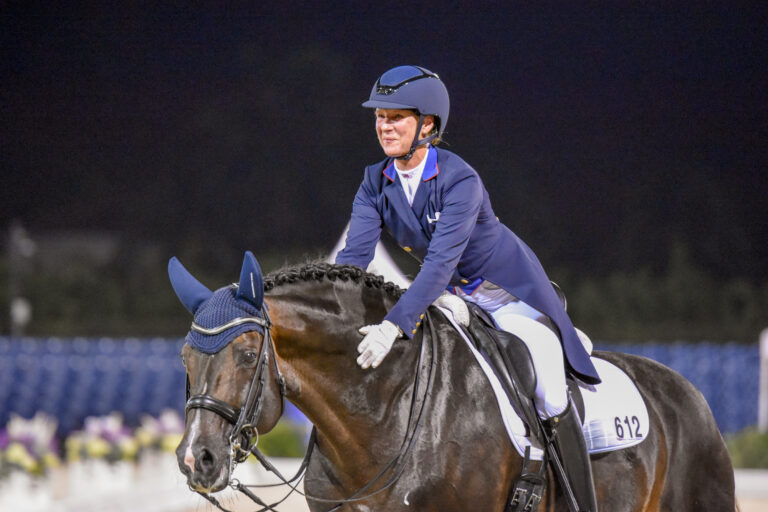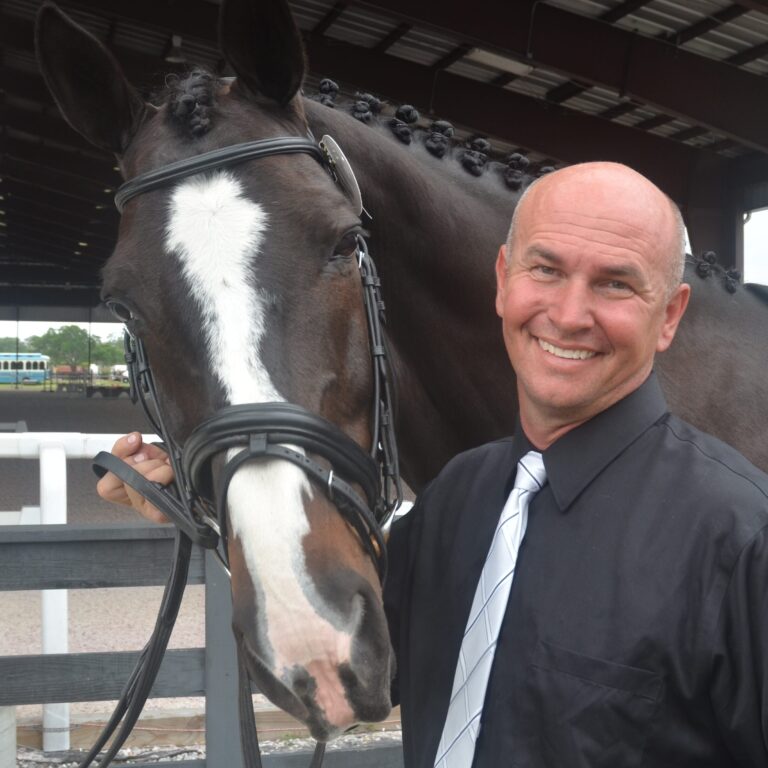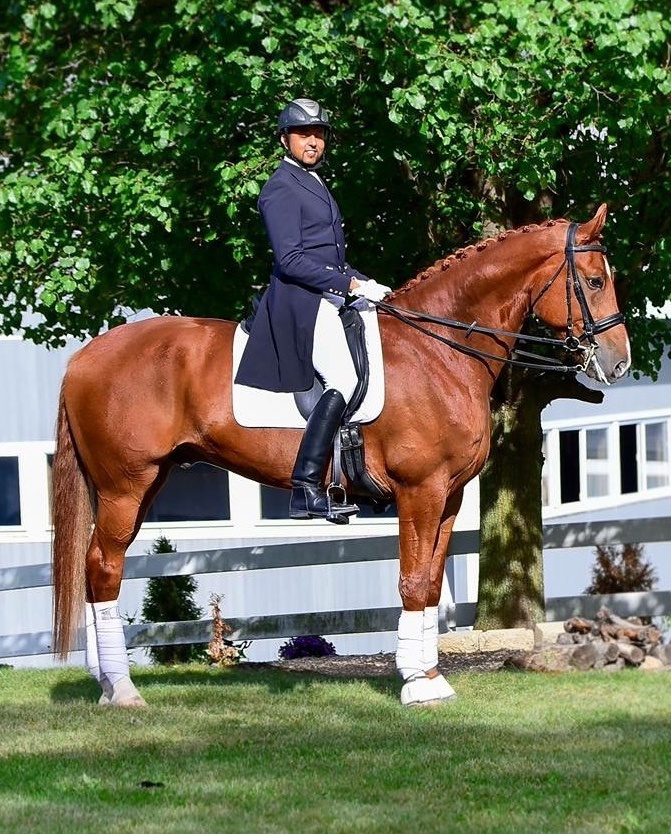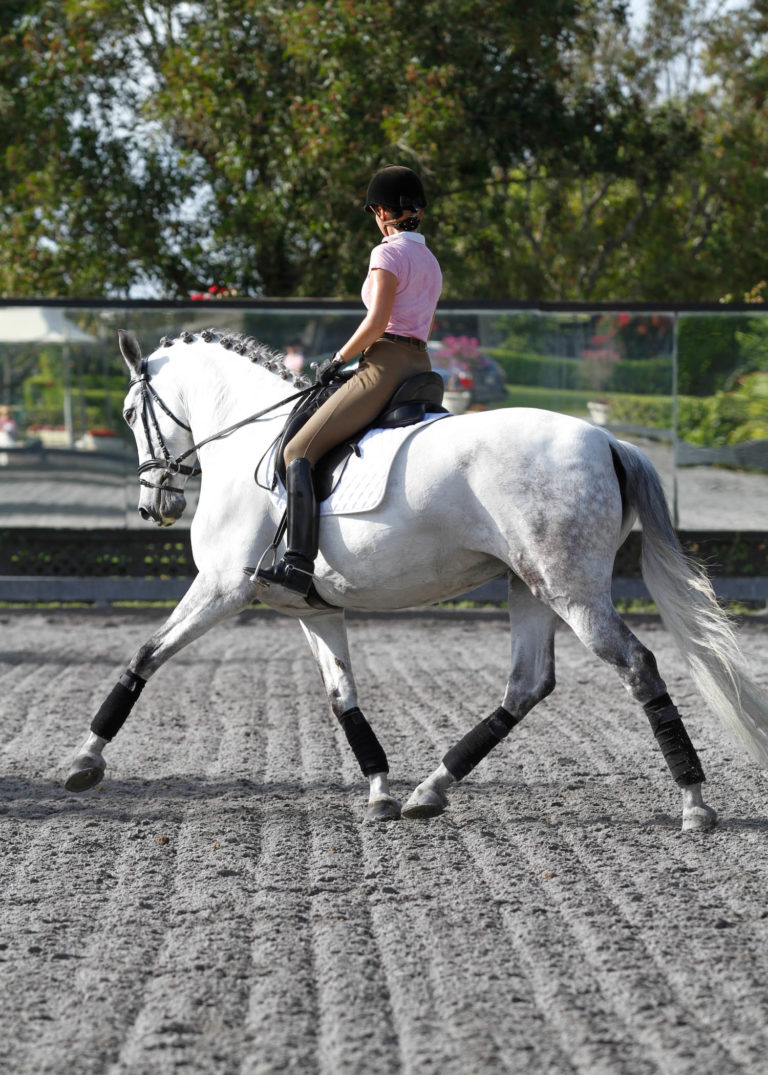When I purchased my first young horse, a yearling Hanoverian/Quarter horse, Warendorf, the breeder warned me, “you will always screw up your first horse.” I, being perhaps an overly confident 18-year-old, scoffed at that comment. After all, I believed I was a decent little event rider at that time.
I ended up with a yearling because, after trying a few three year olds, I quickly became aware that my skills were lacking. With the yearling, I would have two to three years to work on my skills before I would begin the training process.
Today, with much more experience, I have to question my logic at the time. But back then, I had youth and blissful ignorance on my side and I set out on the incredible journey of training my own horse in the sport of dressage.

The journey was anything but easy. Sometimes the road was incredibly bumpy, jostling me this way and that—literally and figuratively. (This is an inside joke between me and all the riders who have sat this horse’s trot) Sometimes the road was lonely. Sometimes I would take a fork in the road, only to discover once I was well down that path that I had, indeed, taken the wrong way and now would have to backtrack many weary miles. Sometimes the path was smooth and easy and I would be lulled into a false sense of security before we would have to, again, wade through rushing rivers to find the path on the other side. The hardest part of training my first horse was not really knowing where my destination was. I was trying to navigate by a star but I had no idea how to read the stars.
Warendorf is now 17 years old. I earned my bronze, bronze freestyle and silver medals on him and my husband later earned his gold medal on him. He is also now an incredible schoolmaster for our program and has helped many of our students earn their medals as well. I have trained many horses since him and each horse teaches me something new about myself. The road was not easy. Anything worth doing seldom is.
In this month’s blog, I want to share some insights I have learned on this journey. One thing to note: Throughout this blog, I will use the words “riding” and “training” interchangeably because when you ride, you are indeed the trainer. The person sitting on the horse is always training the horse, sometimes with the guidance of an instructor and sometimes not. But as the rider, you have responsibility to help your horse.
Keep your standards high.
In the beginning of the journey with a young horse, it is so easy to slip into the thinking of my horse is just a baby and let some of your attention to detail slip. While it is important to be sympathetic to the lack of strength and understanding of the young horse, it is also important to establish good habits right from the beginning. Be clear, consistent, firm and fair with your aids. Give one aid for one desired response and expect quick reactions. The lazy horse, of which I have lots of experience with, can be very good at getting us to aid constantly while he remains unresponsive. The leg then serves only to constantly maintain the energy you already have, however little that energy may be, and the horse becomes dull to the driving aids.
Set your horse and yourself up for success by taking calculated risks. It is imperative to ride your horse to the limit each day, challenging his body and mind so that he grows into his potential over time. By riding to the limit, you keep your horse advancing in his skill, strength and suppleness. This does not mean to ride for a long time until your horse is lathered in sweat. Instead, be very smart with your time, challenging your horse a little more than you did the day before to ensure that you moving forward each day. I rarely ride my horses more than a half an hour at a time but I give 100 percent of my focus and intensity to those 30 minutes. While the basics are vital to good training, don’t be afraid to try something new and get outside of your comfort zone. It is in getting out of your comfort zone that you can grow! Take risks. If it doesn’t work out, don’t worry. You will have gained information that can help you in your future training.
I have a checklist that I go through at the beginning of each ride, and later in this blog, we will dive into that checklist in more detail. (Click here to read it.) This checklist holds me accountable for ensuring that my standards are high right from the moment I put my foot in the stirrup. I check in that my horse is quick to respond from my: forward driving aid, lateral leg aid (left and right), the hand and the seat. Going through this checklist tunes you into where you need to begin your focus on the ride. Once these quick reactions are established, and for some horses this may take a fair amount of time, the work of strengthening, straightening and suppling the horse begins.
Always persevere.
I am convinced that most of my success in riding has been simply because I just keep showing up. When I commit to a decision or set some goal, I have intense focus and will not stop until that goal is achieved.
Sometimes training is hard. Sometimes training is really hard. Training horses as a way of pulling out all of our insecurities. We are all afraid of ruining our horses and we fear that if we have a bad ride, it proves we are not good enough and never will be. I can’t tell you how many days I left the barn feeling like a complete failure. Riding and training horses is so incredibly humbling. Learning a new movement or teaching a horse something new makes us feel vulnerable but it is in the vulnerability that we can grow and expand as a rider. Sometimes the greatest struggle can lead to the greatest reward.
For example, when I was teaching the flying changes to my second young horse, I faced one of my most difficult challenges in my life as a trainer. He was a young stallion, about six years old at the time I started the changes with him. He had competed successfully through Second Level and I felt he was properly prepared to begin learning the changes. Months passed and I could get every variation of a flying change—late behind, late in front, bucking, bolting and everything in between—but never a clean flying change. I was so incredibly discouraged and doubted my abilities more and more with each ride. The whole process took me a year—a year of self-doubt, failure and disappointment. But I persevered. I kept showing up, working on canter quality and transitions and on alignment and activity. Finally, things started to click. At his first show at Third Level, he actually scored 9’s on his flying changes. Only three months prior, I was ready to quit—but I am so glad I didn’t!
Find joy in the process.
The training of the horse is a long and sometimes arduous journey, never to be taken up in haste. A good deal of patience is required. Sometimes it does not go according to the plan. Therefore it is important to stay present in the experience and find joy in the process rather than the outcome. Especially if you show, you have little control over the outcome and basing your happiness and fulfillment on someone else’s judgment can be setting yourself up for frustration and disappointment!
By all means, take dressage seriously but please don’t forget to have a sense of humor! Making the work feel like play is much more enjoyable for you and your horse. At the end of the day, it’s not life and death we are dealing with when training a horse, yet sometimes it feels that way. I know I am guilty of taking riding way too seriously—a bad ride can send me spiraling downward for several days. We should be grateful for every moment we get to spend with these incredible animals and not lose sight of what a precious gift it is.
In the training of the horse, true gratification really is about who you become throughout the journey. The value is in what you learn about yourself. Hopefully you have transformed your horse into something beautiful through the process, but even more than that I hope you have discovered something beautiful in yourself. I hope you have found that you have the strength, endurance and patience to participate in this beautiful, elegant art of dressage.
It’s more fun with friends.
The last element I will discuss today is that of community. Riding has the potential to be very isolating. The time spent with our horse is sacred and something we should always be incredibly grateful for— but I can’t say enough about the importance of community. When I was a young rider and a trainer in my early years, I spent most of my time alone. I would travel between farms but was never really part of a barn community so when my husband and I built our barn and established our business, I was certain I wanted to create a family-type feeling where everyone felt welcome and supported.
If you are already part of a community, you are already putting in place the friends and support that you will need in the darker days of training horses. Like I said, it’s not always rainbows and butterflies. Sometimes we are forced to face our fears, our insecurities and our vulnerabilities in the course of riding and training. It is how we handle our challenges that defines us. Having a community to support us through these difficult times can make all the difference in the world.
If you do not have a community, get involved with your local GMO or find other riders in the area that you can meet up with to ride with. Start a local book club and study one of the wonderful books written about dressage. If you live in a remote area, join an online community. Connection to others who share our passion and understand the ups and downs involved enriches the experience.
The journey of riding and training is one of the most exciting adventures you can ever undertake. The partnership you develop with your horse is like no other. The relationship you can develop with yourself is nothing short of life changing. Enjoy the ride, live in gratitude for every moment spent in the presence of the horse.
Keep your chin up, align your horse and ride forward!
Until next time,
Jenna
To read Jenna’s previous blogs, click here.
Jenna Arnold is a USDF bronze, silver and gold medalist and bronze, silver and gold Freestyle Bar recipient. She is a writer and founder of Mindful Riding, a website and program dedicated to helping riders develop a more meaningful relationship with their horse and with themselves by balancing mind, body and spirit. She is the mother of two young daughters and runs Concordia Dressage with her husband, Martin Arnold, near Austin, Texas.










